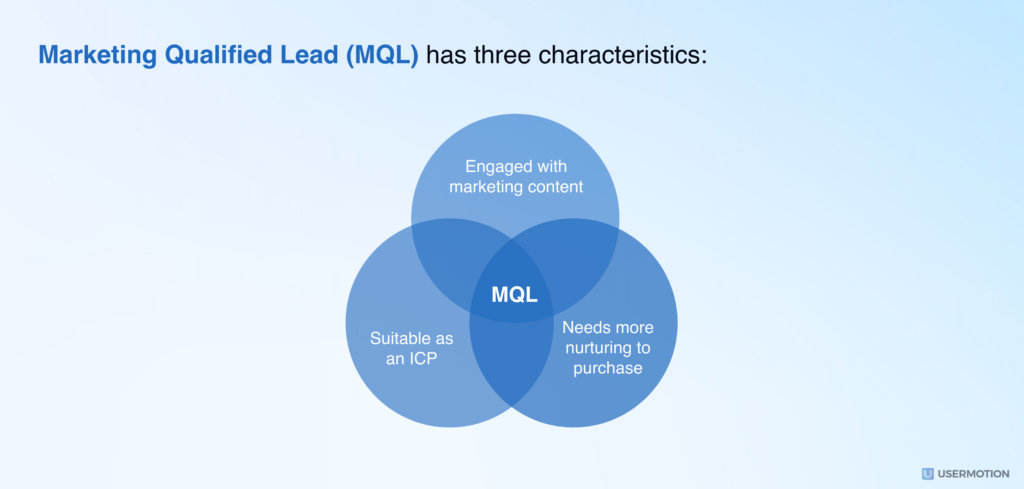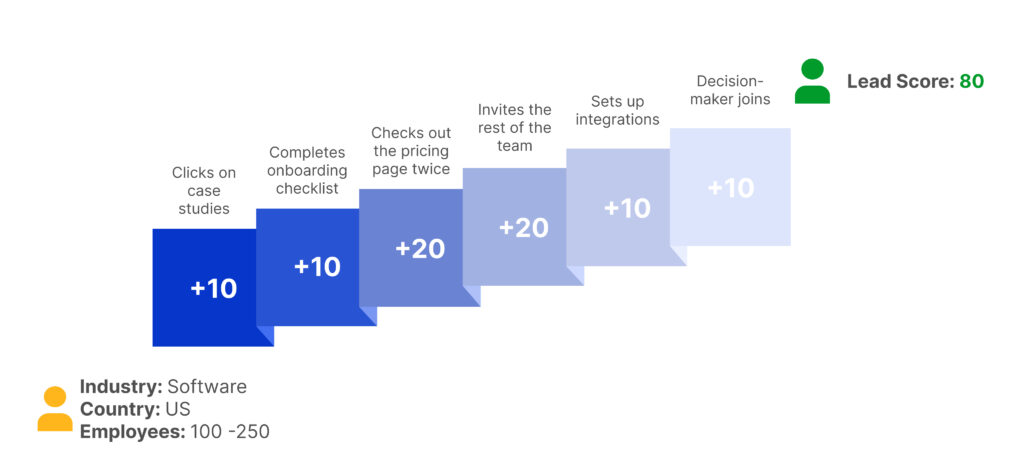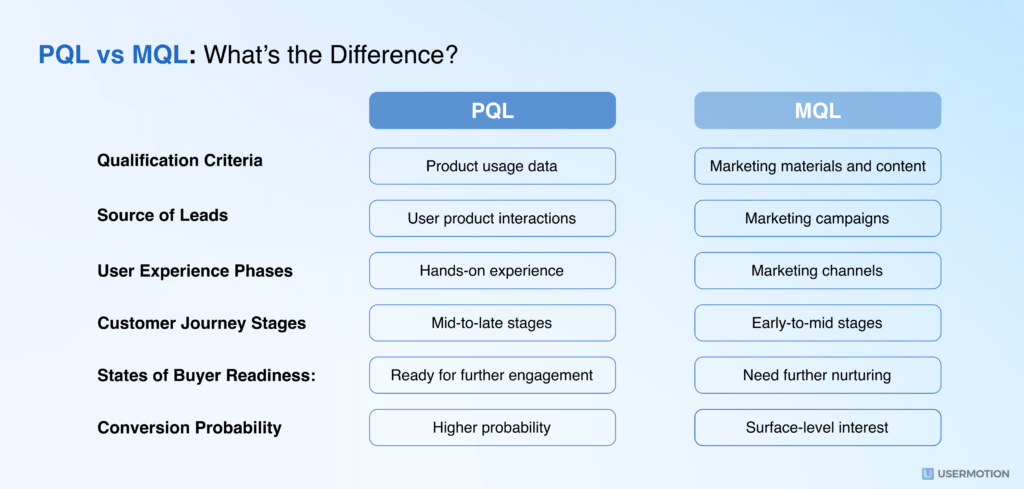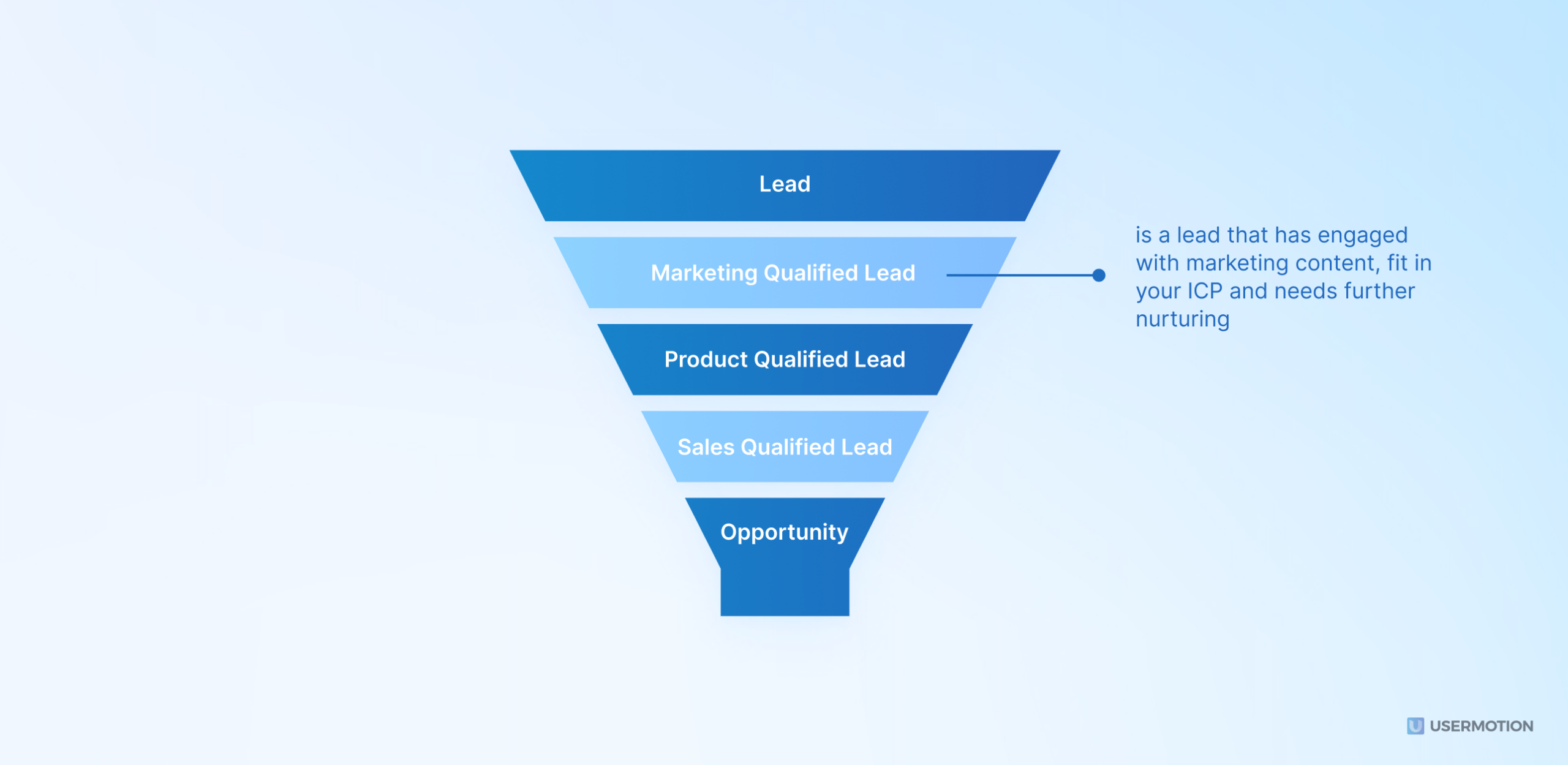In the high-stakes world of business, every lead counts. But not all leads are created equal. Some people are interested, while others are on the brink of becoming your next customer.
The challenge lies in distinguishing these two groups from one another.
Enter the concept of Marketing Qualified Leads (MQLs). They are a critical component in the sales process and can make all the difference in your bottom line.
Are you ready to unlock the potential of MQLs? Let’s get started.
TL;DR
- Marketing Qualified Leads (MQLs) are more likely to become customers. A clear definition is necessary to ensure high-quality leads. It helps efficient sales cycles and improves sales team productivity.
- Identifying MQLs requires tools like lead scoring models. They assign points based on lead behavior and readiness to convert. Alignment between go-to-market teams is crucial. It helps smoothly transition MQLs to Sales Qualified Leads (SQLs).
- Effective MQL to SQL conversion involves nurturing techniques. It also requires personalization through segmentation. Additionally, it requires regular sales and marketing team collaboration. It also requires a robust understanding of conversion metrics for continuous performance improvement.
What is Marketing Qualified Lead (MQLs)
An MQL, or Marketing Qualified Lead, is a lead that has showed the interest of your marketing team. Compared to others, these leads have a higher potential to become customers.
Eventually, they become a sales qualified lead or product qualified lead. They’ve shown interest in your product or service by engaging in ways that meet specific criteria set by your marketing and sales team. Also lead should be also fit as an ideal customer profile.
Why is it necessary to define an MQL? A clear definition of MQLs improves lead quality, makes sales cycles more efficient, and boosts the productivity of the sales team. This way, your sales team can focus on leads with a higher potential for conversion, including Sales Qualified Leads (SQLs).

To elaborate, an MQL is a lead that has shown a level of interest in your product or service that is above average.
This interest can be exhibited in various ways.
For example;
- downloading a whitepaper
- signing up for a newsletter
- spending a significant amount of time on your website.
By defining what actions or behaviors qualify a lead as an MQL, you give your sales team a clear target to aim for.
This helps streamline the sales process. It also ensures that pursued leads are high quality. They have a higher chance of becoming customers. Furthermore, a clear MQL definition allows your marketing team to tailor their strategies and content. This helps them attract more of these high-quality leads.
In essence, defining an MQL is a strategic move that can significantly enhance your sales and marketing efforts. It leads to more efficient sales cycles, increased productivity, and ultimately, a healthier bottom line.
Defining MQLs in Your Business Context
The definition of MQLs is not one-size-fits-all. It needs to reflect the unique aspects of your product and target audience, including prospective customers. Establishing clear MQL criteria helps maintain a consistent flow of quality leads to your sales team. This allows your marketing team to tailor its content and offers effectively, aligning with the target audience.
By using buyer personas, you can refine MQL definitions to cater to the right prospective customer. This increases the potential of converting leads into customers.
How to Identify MQLs
Lead qualification can be challenging without the appropriate tools and techniques. One such tool is lead scoring – a process that assigns scores to leads based on their interactions and information.
This helps pinpoint MQLs by measuring their readiness and potential to convert into customers.
1. Identifying Signs of a Lead Becoming an MQL
As they say, actions speak louder than words. This couldn’t be truer when it comes to identifying MQLs. Specific actions, such as voluntarily submitting contact information, opting into a newsletter, or showing interest in the company’s product or service, indicate that a lead might be transitioning into an MQL.
2. Crafting a Lead Scoring Model

A lead scoring model is an organized system for assessing leads, often referred to as a lead scoring system. You can prioritize leads most likely to convert by assigning point values to different MQL qualifications and behaviors. Lead scoring rules use a predetermined MQL formula to allocate points to leads based on their marketing activities. These activities include website visits, downloading content (ebooks, guides, etc), and email opens.
3. Aligning Scores with Sales and Marketing Teams
It’s important to align lead scoring criteria with both sales and marketing teams for smooth transition between stages. The marketing department identifies MQLs according to the business’s established criteria, like lead scoring, and subsequently directs them to the sales team for additional evaluation. This ensures that the leads passed on to the sales team have an increased potential of converting into customers.
How to convert MQLs to SQLs
After identifying your MQLs, the subsequent step is their conversion into SQLs. This is where methods for nurturing MQLs come into play. These include sending targeted content at opportune times, using high-quality content in nurture campaigns, and segmenting leads for more personalized communication.
Nurturing Techniques for MQLs
Nurturing an MQL is similar to gardening. It involves providing consistent and appropriate conditions for growth. Personalization enhances the nurturing process of MQLs. Segment leads based on specific criteria. Create tailored campaigns for each segment. This can improve engagement and conversion.
- If you have a segment of leads who have shown interest in a specific product, you might create a nurture stream. It would provide detailed information about that product. It would also include customer testimonials and special offers related to the product.
- Nurture leads who have engaged with your content but have not yet made a purchase. These leads might benefit from a series of emails that provide additional value. For example, educational content related to your industry or solutions to common problems they might be facing.
- Nurture leads who have shown high levels of engagement. For example, they regularly visit your website or interact with your brand on social media. These leads might be on the verge of becoming SQLs. A personalized outreach from a sales representative could be the final push they need to convert.
Using multiple nurture streams with relevant content improves engagement and conversion. Tailoring the content to different personas and industries is the key. This is akin to a farmer planting different crops in different fields, each requiring unique care and attention. Each lead is unique, and therefore, their nurturing process should also be unique.
Marketers can help their MQLs flourish by providing the right conditions for growth, like a gardener. This eventually turns MQLs into SQLs.
Criteria for Elevating MQLs to SQL
Before a seed can blossom, it must pass through various stages of growth. Similarly, an MQL must meet certain criteria before it can be considered an SQL. Factors to consider include:
- Tracking progression through each stage of the sales funnel
- Measuring engagement and interest levels
- Determining demographic fit
- Utilizing lead scoring models
- Analyzing interactions such as CTAs clicked, pages visited, and content downloaded.
Collaboration Between Go-to-Market Teams
In the world of marketing, collaboration is key. The synergy between sales and marketing teams, including sales teams, can make all the difference. It can lead to successfully converting MQLs to SQLs.
Communication Strategies for Two Teams
Maintaining clear communication between sales and marketing teams is key for success. This involves agreeing on a buyer persona. It also means setting shared goals and objectives. Finally, it involves identifying key performance indicators (KPIs). Some examples of KPIs could be the number of new MQLs generated, the conversion rate of MQLs to SQLs, or the average time it takes for an MQL to become an SQL.
By fostering a cooperative environment and defining each team’s role, conflicts can be resolved and collaboration enhanced.
Regular Review Sessions
Regular review sessions are like routine maintenance for a machine. They keep the sales-marketing collaboration functioning smoothly. These sessions facilitate progress assessment. They identify areas for improvement and ensure mutual understanding between both teams.
How MQLs different than SQLs, and PQLs
While all leads play a pivotal role in fueling a company’s growth, they are not all the same. This section will distinguish between MQLs, SQLs, and PQLs, each with its unique characteristics and roles in the sales funnel.
MQL vs SQL
In contrast to MQL, an SQL, or Sales Qualified Lead, denotes an individual who has passed the initial engagement stage. They are now prepared to engage directly with the sales process. They’ve shown a clear intent to make a purchase of the offered product or service and are ready for a more direct, personalized sales approach.
To illustrate the difference between MQLs and SQLs, consider the following table:
| MQL | SQL | |
|---|---|---|
| Stage in Sales Process | Intermediate stage, after initial engagement but before direct sales engagement. | Advanced stage, ready for direct sales engagement. |
| Sales Approach | Not yet prepared for personalized engagement from the sales team. | Primed for a direct, personalized sales approach. |
| Example | A lead that has downloaded a white paper or subscribed to a newsletter. | A lead that has requested a demo or a sales call. |
MQL vs PQL
A PQL, or Product Qualified Lead, is a lead who has derived significant value from your product through a free trial or freemium model. These leads have not only shown interest, but have also experienced your product first-hand and found it valuable. This makes them highly likely to convert into paying customers.
To help illustrate the differences between MQLs and PQLs, consider the following table:

Tools to Track MQL
In the era of digital technology, utilizing its power is a necessity, not a choice. Tools such as CRM systems and automation can significantly improve the management and progression of MQLs.
Customer Relationship Management
Customer Relationship Management (CRM) systems are not just a lifesaver but a time-saver when it comes to managing MQLs. They play a crucial role in organizing lead data, tracking engagement, and ensuring timely follow-up on leads. Some popular CRMs include:
- Salesforce: Known for its comprehensive features, Salesforce offers robust tools for managing leads, tracking customer interactions, and automating marketing tasks.
- HubSpot: HubSpot’s CRM is user-friendly and comes with a suite of integrated inbound marketing tools. It allows tracking of every interaction a lead has with your content, making it easier to identify MQLs.
- Pipedrive: Pipedrive is a sales-focused CRM that helps you plan your activities based on your sales pipeline. It offers great visualization of sales processes and is easy to use.
For instance, if a lead downloads an eBook from your website, the CRM system will automatically record this action. It will mark the lead as an MQL and could help you to schedule a follow-up email to nurture the lead further.
Similarly, if a lead attends one of your webinars, the CRM system will track this engagement and schedule a follow-up call from the sales team. Thus, CRM systems automate various tasks, making the process of managing MQLs much more efficient and effective.
Predictive Lead Scoring Tools
Predictive lead scoring tools are a vital component of the MQL identification process. These tools use a combination of data points and predictive analytics. They determine which leads are most likely to convert into customers. The predictive lead scoring tools analyze various factors. These include the lead’s demographic information, behavioral patterns, and engagement with the company’s content.
The advantage of using predictive lead scoring tools is their ability to analyze vast amounts of data quickly and accurately. They can sift through hundreds or even thousands of data points to identify patterns and trends that might be missed by the human eye.
These tools are not just about assigning scores to leads. They are about predicting the future actions of leads based on their past behaviour. This can provide valuable insights that can help guide your marketing strategies and sales efforts.
Here are some examples:
- 6sense: 6sense’s Account Engagement Platform employs predictive modeling to identify the most promising leads and accounts. It monitors engagement and intent signals to deliver a more accurate lead score.
- HubSpot: HubSpot is not just a user-friendly CRM with a suite of integrated inbound marketing tools, but it also provides a robust feature for lead scoring, enabling businesses to assign value to their leads based on their interactions and engagement levels, thus helping in the effective identification of MQLs.
- Outfunnel: Outfunnel is a powerful marketing automation tool that seamlessly integrates with your CRM, providing marketers with the ability to automate and align their sales and marketing efforts, thereby making it easier to identify and nurture MQLs.
Analytics Tools
In the digital age, businesses rely on analytics tools. They use them to track and manage their Marketing Qualified Leads (MQLs). These tools provide a comprehensive view of your leads’ behaviors. They also show interactions and engagement levels. They help you identify potential MQLs and guide them through the sales funnel.
- Google Analytics: This tool allows you to track website traffic and user behavior, providing insights into which pages or content are attracting potential MQLs. You can also set up goals to track conversions and monitor how leads are interacting with your site.
- Marketo: Marketo provides a robust marketing automation platform with advanced analytics capabilities. It helps in tracking the digital footprints of leads, scoring them based on their actions, and nurturing them with personalized content.
- Pardot: As part of the Salesforce family, Pardot offers B2B marketing automation features with a focus on analytics. It allows for tracking and scoring of leads based on their activities, helping you identify and prioritize MQLs.
- Kissmetrics: This tool is designed to understand, segment and engage your audience based on their behavior. It provides insights into how leads are interacting with your website and content. This helps you identify potential MQLs.
By using these analytics tools, you can better understand your leads. You can also identify potential MQLs. Then, optimize your marketing strategies to nurture these leads effectively.
Analyzing MQL Conversion Metrics
Understanding your MQL conversion metrics provides a clear direction, much like a compass. It points you in the right direction, helping you navigate the vast landscape of leads and pinpoint areas of improvement.
These metrics provide valuable insights into your leads’ journey through the sales funnel. They are instrumental in assessing how well your strategies are working. Here are some important metrics to consider:
- MQL to SQL Conversion Rate: This metric measures how many of your MQLs are progressing to become SQLs. A high MQL to SQL conversion rate indicates that your marketing efforts are successfully nurturing leads and moving them further along in the sales funnel.
- Lead-to-Customer Conversion Rate: This metric shows the percentage of leads that eventually become customers. This is crucial for understanding the overall effectiveness of your marketing and sales strategies.
- Cost per MQL: This metric helps you understand how much you’re spending to acquire each MQL. By keeping an eye on this, you can ensure you’re investing your resources wisely and getting a good return on your marketing investment.
- Time to Conversion: This measures the average time it takes for an MQL to become an SQL and then a customer. This can help you identify any bottlenecks in your sales process and make necessary adjustments.
By closely monitoring these metrics, you can understand how effective your marketing efforts are. You can make data-driven decisions to optimize your strategies.
7 Examples of Marketing Qualified Leads
Having discussed the theory, let’s illustrate with seven examples of MQLs. These are leads that have shown interest in your product or service by engaging in ways that meet specific criteria set by your marketing team.
From submitting contact information to opting into a newsletter, these actions indicate that a lead is not only interested but actively engaged. These are the seeds that, with the right nurturing, can blossom into SQLs and eventually into paying customers.
Let’s break it down:
- A lead who has filled out a form on your website to download an eBook or white paper is showing a clear interest in your product or service. They’re willing to provide their contact information in exchange for valuable content. This indicates a higher level of engagement.
- If a lead has signed up for a free trial of your product or service, they’re showing a strong potential to convert into a customer. They’re willing to invest their time and energy into trying out what you have to offer.
- Leads who attend your webinars or other online events are also highly engaged. They’re willing to spend their time learning more about your product or service, which suggests they’re seriously considering making a purchase.
- Regularly visiting your website or specific product pages is another sign of a potential MQL. Frequent visits suggest that the lead is actively researching your product and is likely moving closer to a purchase decision.
- Leads who engage with your brand on social media, such as liking, sharing, or commenting on your posts, are showing a high level of interest and engagement. They’re not only consuming your content but also interacting with it, which is a positive sign.
- If a lead has opted into your email newsletter, they’re indicating a desire to stay informed about your company and its offerings. This ongoing engagement can help keep your brand top-of-mind when they’re ready to make a purchase.
- Finally, leads who request a demo or a sales call are showing a very high level of interest. They’re ready to have a direct conversation about your product or service. This makes them a prime candidate for conversion into an SQL and, ultimately, a paying customer.
Final Thoughts
In conclusion, MQLs are the seeds that, with the right nurturing, can blossom into SQLs and eventually into paying customers. By defining MQLs and creating a lead scoring model, you can streamline the management and progression of MQLs. Utilizing tools like CRM systems and automation helps too. Analyze data insights continuously and adjust tactics based on these insights. This way, you can optimize MQL conversion rates and overall sales success.





